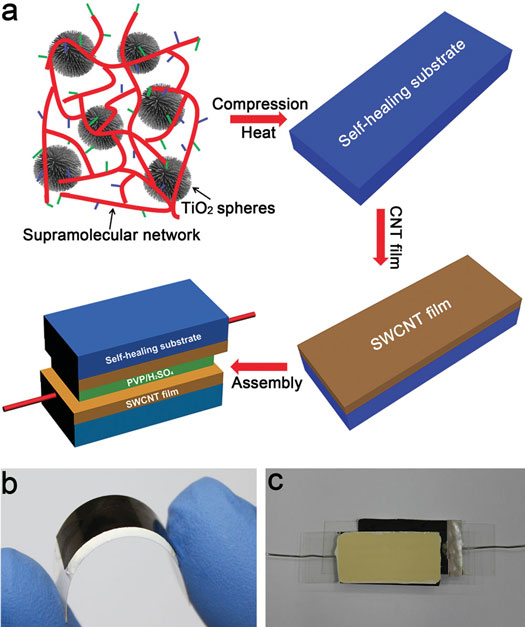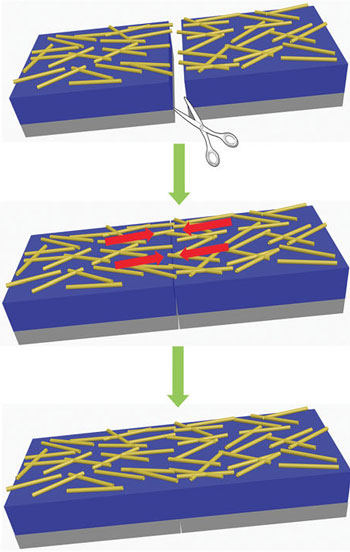| Posted: Mar 10, 2014 | |
Self-healing carbon nanotube supercapacitors |
|
| (Nanowerk Spotlight) If you ever had problems with the (non-removable) battery in your iPhone or iPad then you well know that the energy storage or power source is a key component in a tightly integrated electronic device. Any damage to the power source will usually result in the breakdown of the entire device, generating at best inconvenience and cost and in the worst case a safety hazard and your latest contribution to the mountains of electronic waste. | |
| A solution to this problem might now be at hand thanks to researchers in Singapore who have successfully fabricated the first mechanically and electrically self-healing supercapacitor. | |
| Reporting their findings in Advanced Materials ("A Mechanically and Electrically Self-Healing Supercapacitor") a team led by Xiaodong Chen, an associate professor in the School of Materials Science & Engineering at Nanyang Technological University, have designed and fabricated the first integrated, mechanically and electrically self-healing supercapacitor by spreading functionalized single-walled carbon nanotube (SWCNT) films on self-healing substrates. | |
 |
|
| The design and manufacturing process flow of a flexible, electrically and mechanically self-healing supercapacitor. The self-healing composite is composed of hierarchical flower-like TiO2 nanostructures (black spheres) and a supramolecular network (red wires) with a large amount of hydrogen bond acceptors (blue rods) and donors (green rods), which is then compressed under heat to form a self-healing substrate. Carbon nanotube (CNT) films are deposited on the self-healing substrates, which are then assembled to form the sandwiched supercapacitors. b) Optical image of a flexible self-healing substrate on PET sheet after deposition of the CNT film. c) Optical image of an integrated self-healing supercapacitor. (Reprinted with permission from Wiley-VCH Verlag) | |
| "The successful preparation of this self-healing supercapacitor may provide a way to expand the lifetime of future energy storage devices and empower them with desirable economic and human safety attributes," Chen tells Nanowerk. "In addition, our work can motivate researchers to explore other next-generation self-healing electronic devices." | |
| Inspired by the biological systems’ intrinsic self-repairing ability, a class of artificial 'smart' materials, called self-healing materials, which can repair internal or external damages have been developed over the past decade (for instance, see our previous Nanowerk Spotlights: "Nanotechnology material, heal thyself" and "Nanocoated fabric is super-repellent and self-healing"). | |
| Besides restoring mechanical and structural properties, recovery of function after damage has recently been emphasized and successfully achieved in several functional materials (see for instance: "Creating indestructible self-healing circuits"). Nevertheless, further progress in fabrication of integrated functional electronic devices with self-healing attribute remains a challenge. | |
| Chen notes that, in order to achieve a functional supercapacitor capable of damage self-healing, the restoration of electrical conductivity after damage is of foremost importance. | |
| "We worked on the assumption that that the integration of appropriate self-healing materials into supercapacitor devices could prevent the structural fractures of electrode materials, as well as restore the configuration integrity and electrical properties of the devices after mechanical damage," he says. | |
| Recently, to meet the requirements of miniaturized portable electronic devices, great efforts have been devoted to flexible and lightweight supercapacitors. Most of these supercapacitors suffer from mechanical fragility – when subjected to practical application, the electrode materials become susceptible to structure fractures under bending or during charge and discharge process, while the polymeric flexible substrates may possibly undergo mechanical damage caused by deformation over time or accidental cutting. This seriously limits the reliability and lifetime of the supercapacitors. | |
 |
|
| Schematic representation of self-healing capabilities of electrical conductivity of as-prepared SWCNT films spread on self-healing substrates. (Reprinted with permission from Wiley-VCH Verlag) | |
| In their supercapacitor configuration, Chen's team used a titanium dioxide nanocomposite material as self-healing substrate onto which they spread an approximately 20µm thick functionalized SWCNT film. | |
| "Upon being subjected to mechanical damage, lateral movement of the self-healing composite layer brings the separated areas of the SWCNT layer into contact, hence enabling the restoration of the device’s configuration and conductivity," explains Chen. "That's basically how we fabricated our integrated self-healing supercapacitor." | |
| When testing the self-healing performance of their flexible solid-state supercapacitors by cutting the electrodes in half, the researchers found that the specific capacitance can be restored by up to 85.7% even after the fifth cutting. | |
| Chen says that the restoration performance could be further improved through the optimization of operation techniques or replacing the non-conductive self-healing substrates by the conductive self-healing composites such as micro-nickel particles incorporated supramolecular networks. | |
| "The successful preparation of this self-healing supercapacitor may provide a way to expand the lifetime of future energy storage devices and empower them with desirable economic and human safety attributes. Our work may be the stepping stone towards the design and fabrication of various next-generation self-healing electronic devices in the future." | |
 By
Michael
Berger
– Michael is author of three books by the Royal Society of Chemistry:
Nano-Society: Pushing the Boundaries of Technology,
Nanotechnology: The Future is Tiny, and
Nanoengineering: The Skills and Tools Making Technology Invisible
Copyright ©
Nanowerk LLC
By
Michael
Berger
– Michael is author of three books by the Royal Society of Chemistry:
Nano-Society: Pushing the Boundaries of Technology,
Nanotechnology: The Future is Tiny, and
Nanoengineering: The Skills and Tools Making Technology Invisible
Copyright ©
Nanowerk LLC
|
|
|
Become a Spotlight guest author! Join our large and growing group of guest contributors. Have you just published a scientific paper or have other exciting developments to share with the nanotechnology community? Here is how to publish on nanowerk.com. |
|
